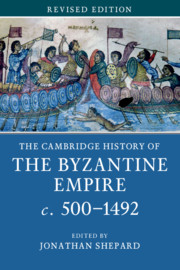Book contents
- The Cambridge History of the Byzantine Empire c. 500–1492
- Frontispiece
- The Cambridge History of the Byzantine Empire c. 500–1492
- Copyright page
- Contents
- Maps
- Illustrations
- Tables
- Dedication
- Preface
- Preface to the Paperback Edition
- General Introduction
- Part I The Earlier Empire c. 500–c. 700
- Part II The Middle Empire c. 700–1204
- Chapter 5 State of Emergency (700–850)
- Chapter 6 After Iconoclasm (850–886)
- Chapter 7 Religious Missions
- Chapter 8 Armenian Neighbours (600–1045)
- Chapter 9 Confronting Islam: Emperors Versus Caliphs (641–c.850)
- Chapter 10 Western Approaches (700–900)
- Chapter 11 Byzantine Italy (680–876)
- Chapter 12 The Middle Byzantine Economy (600–1204)
- Chapter 13 Equilibrium to Expansion (886–1025)
- Chapter 14 Western Approaches (900–1025)
- Chapter 15 Byzantium and Southern Italy (876–1000)
- Chapter 16 Belle Époque or crisis? (1025–1118)
- Chapter 17 The Empire of the Komnenoi (1118–1204)
- Chapter 18 Balkan Borderlands (1018–1204)
- Chapter 19 Raiders and Neighbours: The Turks (1040–1304)
- Part III The Byzantine Lands in the Later Middle Ages 1204–1492
- Glossary (Including Some Proper Names)
- Genealogical Tables and Lists of Rulers
- Alternative Place Names
- Bibliography
- Book part
- Picture Acknowledgements
- Index
Chapter 6 - After Iconoclasm (850–886)
from Part II - The Middle Empire c. 700–1204
Published online by Cambridge University Press: 04 November 2019
- The Cambridge History of the Byzantine Empire c. 500–1492
- Frontispiece
- The Cambridge History of the Byzantine Empire c. 500–1492
- Copyright page
- Contents
- Maps
- Illustrations
- Tables
- Dedication
- Preface
- Preface to the Paperback Edition
- General Introduction
- Part I The Earlier Empire c. 500–c. 700
- Part II The Middle Empire c. 700–1204
- Chapter 5 State of Emergency (700–850)
- Chapter 6 After Iconoclasm (850–886)
- Chapter 7 Religious Missions
- Chapter 8 Armenian Neighbours (600–1045)
- Chapter 9 Confronting Islam: Emperors Versus Caliphs (641–c.850)
- Chapter 10 Western Approaches (700–900)
- Chapter 11 Byzantine Italy (680–876)
- Chapter 12 The Middle Byzantine Economy (600–1204)
- Chapter 13 Equilibrium to Expansion (886–1025)
- Chapter 14 Western Approaches (900–1025)
- Chapter 15 Byzantium and Southern Italy (876–1000)
- Chapter 16 Belle Époque or crisis? (1025–1118)
- Chapter 17 The Empire of the Komnenoi (1118–1204)
- Chapter 18 Balkan Borderlands (1018–1204)
- Chapter 19 Raiders and Neighbours: The Turks (1040–1304)
- Part III The Byzantine Lands in the Later Middle Ages 1204–1492
- Glossary (Including Some Proper Names)
- Genealogical Tables and Lists of Rulers
- Alternative Place Names
- Bibliography
- Book part
- Picture Acknowledgements
- Index
Summary
Two emperors dominate the generation or so following iconoclasm, Michael III the Amorian (842–67) and Basil I the Macedonian (867–86). The story of this pair is intimately intertwined, although it climaxed with the assassination of the former at the instigation of the latter on the night of 23 September 867 in Michael’s bedroom in the palace of St Mamas. Thus began the long ascendancy of the Macedonian dynasty, which witnessed the peak of Byzantium’s power. A clear understanding of the reigns of Michael and Basil is, however, fraught with difficulty given the nature of our main narrative sources. These are both late – dating to the mid-tenth century – and polarised. The Macedonians were naturally keen to justify the ousting of Michael III, so he is depicted in Theophanes Continuatus and Genesios as unworthy of imperial power and deserving of his fate. The Macedonians were also concerned to present Basil in the best possible light, as God-favoured and preordained to rule. The most famous expression of this is the Life of Basil (which forms book five of Theophanes Continuatus’ chronicle), written in the reign of his grandson Constantine VII Porphyrogenitus (945–59), though we also have Leo VI’s Funeral oration for Basil I (dated to 888) and poems and artefacts from Basil’s reign. However, a hostile view of Basil is provided by the chronicle of Symeon the Logothete, which also treats Michael more ambiguously. Despite these sources’ polarity and emphasis on court politics it is clear that there was continuity in the goals of the two regimes. The security of the east was paramount, although the west was still of concern. The government also had to cope with the Arab naval menace and the potential Bulgar threat from the north. New opportunities were seized when they arose, among Moravians, Armenians and the Rus. Such were the achievements of an era that it is usually characterised as a decisive turning-point, if not a belle époque. But it is clear that they followed upon an already advancing recovery, as much a cultural as a political revival. One should also recognise that this was not a period of unbroken success.
- Type
- Chapter
- Information
- The Cambridge History of the Byzantine Empire c.500–1492 , pp. 292 - 304Publisher: Cambridge University PressPrint publication year: 2019
- 1
- Cited by

